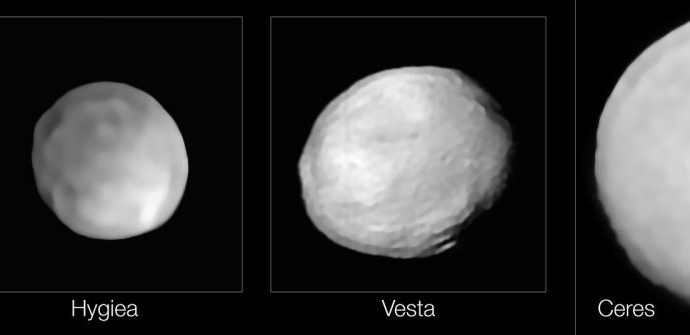Although it’s just 270 miles across — about as big as Alabama — the asteroid Hygeia has surprised astronomers by being round.
Source: NBC News
An asteroid orbiting the sun has surprised astronomers by turning out to be roughly spherical in shape – possibly qualifying it to be the smallest dwarf planet in the solar system, according to a study by a team of astronomers.
The asteroid, named Hygeia, is the fourth-largest object orbiting in the asteroid belt between Mars and Jupiter, after the dwarf planet Ceres and the asteroids Vesta and Pallas.
Because it’s a lot smaller than Vesta and Pallas, Hygeia was thought to have an irregular shape like them rather than a spherical shape formed under the force of its own gravity, like Earth and the other rocky planets. But astronomers have found that Hygeia is round, and that its relatively weak gravity is the reason.
That could qualify it to be considered a dwarf planet under the definition adopted by the International Astronomers Union, which in 2006 controversially demoted Pluto from its status as the ninth planet of the solar system.
The IAU voted that a planet is an object that orbits the sun, but is not a moon of another object; that it has cleared its neighborhood in space of smaller objects; and that it has enough mass for its own gravity to pull it into a spherical shape. Because Pluto shares some of its orbit with other objects, including the distant dwarf planet Eris, the IAU downgraded it to a dwarf planet.
The decision means the IAU considers the solar system to have eight planets, instead of nine – although it is possible that more might exist.
Hygeia was first seen in 1849 as a moving spot in a telescope. It’s thought to have formed into its current shape between 2 billion and 3 billion years ago, when it collided with another asteroid.
That collision created one of the largest asteroid families in the solar system, made up of almost 7,000 asteroids that can be recognized by the wavelengths of sunlight they reflect.
It was also thought to have left a scar.
“Everybody believed that Hygiea suffered a large collision in the past, and we expected to find a large crater,” said astronomer Miroslav Brož of Charles University in Prague in the Czech Republic, a co-author of the study. But instead of finding evidence of an ancient impact, observations with the European Very Large Telescope in the Atacama Desert in Chile revealed Hygeia was unexpectedly round – a consequence of the massive collision, when its fragments of rock behaved for a time like a liquid.
“The parent body was completely disrupted and subsequently re-accreted into a roughly spherical body,” said the lead author, astronomer Pierre Vernazza of the Laboratoire d’Astrophysique de Marseille in France. “So the rather spherical shape is a consequence of the violence of the impact.”
The observations were also able to determine an accurate figure for the size of Hygeia – a bit less than 270 miles across. That’s about the size of Alabama, and a lot smaller than the dwarf planets Ceres – almost 600 miles across – and Pluto, which is almost 1,500 miles across.
Both authors said they think Hygeia should now be considered a dwarf planet.
“I don’t think it has implications for larger objects, but rather for smaller ones,” Vernazza said. “We can’t exclude that the future will reveal even smaller dwarf planet candidates.”
“It fulfils the official definition,” Brož said. “Alternatively, we should improve the definition, right?”
But some other astronomers are not sure if Hygeia should be classified as a dwarf planet.
“The dwarf planet designation always seemed artificial to me,” astrophysicist Steven Soter of the American Museum of Natural History in New York said in an email.
He said the IAU designation was a compromise to preserve Pluto as some kind of planet after astronomers discovered it was only one of thousands of Kuiper Belt objects in the outer solar system.
“So they introduced roundness as a new criterion,” Soter said.
Source: NBC News

































Leave a Comment
You must be logged in to post a comment.